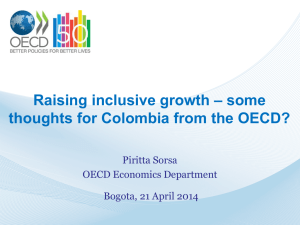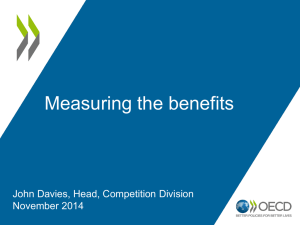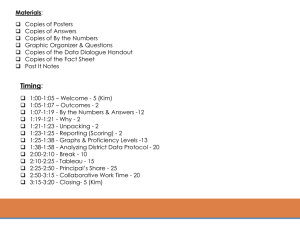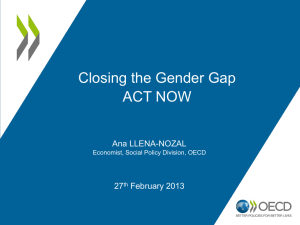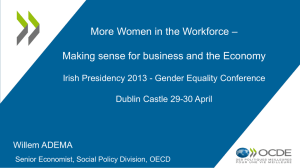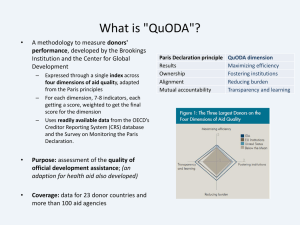Gender Equality in Education, Employment and Entrepreneurship
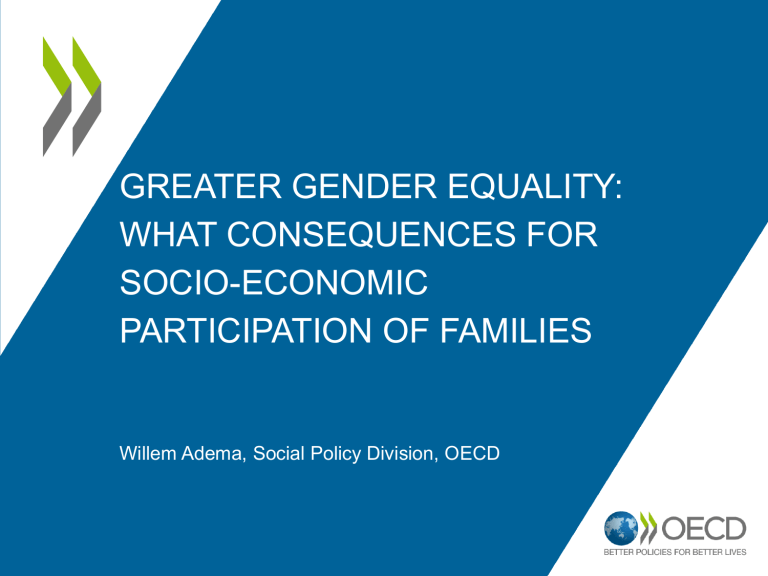
GREATER GENDER EQUALITY:
WHAT CONSEQUENCES FOR
SOCIO-ECONOMIC
PARTICIPATION OF FAMILIES
Willem Adema, Social Policy Division, OECD
This presentation covers three broad topics:
1.
Gender and socio-economic outcomes
2.
Policy objectives and policy levers
3.
Looking ahead
1.
Gender and socio-economic outcomes
Women are more likely to be poor: especially when they get older
Relative income poverty by gender as measured against 50% of national median equivalised income, unweighted average across OECD countries.
Female Male
175
150
125
100
75
50
0-17 18-25 26-40
Source: OECD (2008), Growing Unequal?
41-50 51-65 66-75 above 75
Education is a key driver of greater gender equality
•
Developing countries are catching up: enrolment in primary education is near universal in many countries.
•
Gender gaps in secondary education persist in Eastern,
Middle and Western Africa and Southern Asia, as associated with relatively high rates of early marriage.
•
Increased education accounts for about half the economic growth in the OECD over the past 50 years.
•
Greater gender equality in educational attainment has a strong positive effect on economic growth.
Girls top boys in reading but lag a bit in mathematics. Attitudes play a key role.
PISA students score point differences and survey responses.
Boys's scores minus girl'scores
Reading
-60 -45 -30 -15
PISA score point difference
Mathematics
0 15 30
Chile
United States
United Kingdom
Korea
Indonesia
Australia
Japan
OECD
Germany
France
New Zealand
Finland
Jordan
0
Percentage of boys and girls who read for enjoyment
Girls Boys
20 40 60 80 100
%
Right-hand panel: the difference between girls and boys in Korea is not statistically significant
Source: OECD (2012), PISA 2009 database.
Women are nowadays often better educated than men.
Percentage of the population that has attained at least upper secondary education by age, 2009
Women
4
3
6
5
2
1
10
9
8
7
%
100 80 60 40 20
Source: OECD (2011), Education at a Glance 2011
Men
0
Korea
United States
Germany
France
Australia
OECD
United Kingdom
New Zealand
Portugal
Turkey
0 20 40 60 80 100 %
But are more likely to graduate in the arts and humanities rather than science
Proportion of tertiary degrees awarded to women in 2000 and 2009
Health and Welfare Computing
0
France
Korea
Germany
United Kingdom
OECD
Netherlands
Australia
United States
New Zealand
Norway
Slovak Republic
0 % 100 80 60 40 20 20 40 60 80
Source: OECD (2012), Gender Equality in Education, Employment and Entrepreneurship
(www.oecd.org/gender)
100 %
Female employment has grown, but much of it is part-time.
Female employment-to-population ratio and the female proportion of part-time workers.
Women employment/population ratios
% 100 80 60 40 20 0
Norway
Netherlands
New Zealand
Australia
Germany
United Kingdom
United States
Japan
France
OECD
Korea
Slovak Republic
Turkey
0
Percentage of women in part-time employment
20 40 60 80 100 %
Part-time data for Australia refer to 2001 and for Japan to 2002 (instead of 2000)
Source: OECD (2012), Employment Outlook.
Gender wage gaps have declined, but remain significant, especially at the top
Gender wage gap: the difference between male and female wages divided by male wages at the median and at the 9 th decile of the earnings distribution.
2010 2000 Median Top 10%
Korea
Japan
Germany
United States
United Kingdom
OECD
Sweden
Australia
Italy
New Zealand
Hungary
50 40 30 20 10 0 0 10 20 30
%
Source: OECD (2012), Gender Equality in Education, Employment and Entrepreneurship
(www.oecd.org/gender)
40 50
%
%
200
150
100
-50
-100
50
0
Gender pay gaps are strongly related to gender differences in working hours
Age/Work experience
Decomposing the gender pay gap, most recent year.
Hours worked Education Job characteristics Other demographics Unexplained
Countries are ranked by decreasing proportion of the unexplained gender pay gap.
Source: OECD (2012), Gender Equality in Education, Employment and Entrepreneurship
(www.oecd.org/gender)
Working hours are also key to explaining why female entrepreneurs fare less well than their male counterparts
•
About 30% of businesses are owned by women, but less than 10% of the largest companies are majority-owned by women.
•
Women are more likely to become entrepreneurs because of economic necessity or work/life balance concerns.
•
Women-owned businesses have lower returns, as they start with limited management experience and spend less time on their businesses.
•
Women are the majority of business owners in the informal sector across the globe.
•
Gender pay-gaps among the self-employed around 30 to
40%.
More education & economic participation by women has increased “assortative mating”..
Percentage of workers in earnings decile with a spouse in the same earnings decile, working couple-households, mid-1980s and mid-2000s
Notes: Equivalent household earnings are the sum of gross earnings from all household members, corrected for differences in household size with an equivalence scale (square root of household size).
Source: OECD (2011), Divided We Stand (www.oecd.org/els/social/inequality)
Increasing female employment reduces household earnings inequality while “assortative mating ” increases it.
Trends in earnings inequality decomposed by labour market and demographic factors.
Notes: Equivalent household earnings are the sum of gross earnings from all household members, corrected for differences in household size with an equivalence scale (square root of household size).
Source: OECD (2011), Divided We Stand (www.oecd.org/els/social/inequality)
2.
Policy objectives and policy levers
Gender equality is both a moral as well as an economic imperative
•
Fairness and equity: equal opportunities in fulfilling individual aspirations – women economic empowerment.
•
Policies to help men and women reconcile work and family life are key to fulfilling personal aspirations:
–
Pursuing labour market opportunities
–
Enabling people to have children at their preferred time
–
Reducing family poverty and enhancing child development
•
These objectives generally reinforce each other.
•
A more efficient use of economic resources mobilises hitherto unused labour supply, improves family resources, strengthens the tax base, and promotes economic growth .
Gender equality policy within government is often not pursued effectively…..
•
In many countries around the world social and cultural norms restrict social-economic participation of girls and women.
•
Limited government accountability, lack of awareness and capacity to monitor “impact assessments” of policy choices within the public service.
•
Public gender agencies often lack visibility, authority and resources to effectively advance gender equality across the whole of government.
… possible policy responses include:
•
Increase both quantity and quality of data by gender and improve evaluations of public policy.
•
Set realistic targets for women in senior management in the public service.
•
Enhance gender impact assessments in laws, budgets, policies in a systematic manner
•
Reform legal frameworks where necessary and provide financial incentives and improve compliance mechanisms to change discriminatory attitudes.
Different emphases in underlying objectives lead to different national policy mixes
Public spending on family benefits in cash, services and tax measures, in per cent of GDP, 2009
Notes: Public support accounted here only concerns public support that is exclusively for families
Source: OECD Social Expenditure database (www.oecd.org/els/social/expenditure) provisional data
Public investment in formal childcare can help generate high participation rates
Proportion of children aged less than 6 enrolled in formal childcare, 2008
Public expenditure in formal childcare, 2007
Notes: Numbers do not reflect the intensity of participation; each child is counted regardless of hours of participation.
Source: OECD Family database (www.oecd.org/social/family/database )
Childcare is a key driver of female labour supply and reduces pay gaps
•
The OECD gender report shows:
•
Higher enrolment in formal childcare increases female
Gender pay gaps and enrolment rates in formal childcare 2008*
Gender pay gap age 30-34
%
30
SVK
R² = 0.564
employment on a full-time and part-time basis, and reduces pay gaps.
25
20
15
CZE
AUT
DEU
CAN
JPN
USA
AUS
FIN
KOR
GBR DNK Increasing public spending on childcare does not 10 IRL
NZL
NOR
BEL necessarily lead to more PT employment as it facilitates
5
0 moving into FT work and/or increases quality of care but not care-hours per week.
0 20 40 60
Enrolment rates of children in formal care, 2008
Sources: OECD Family database
(www,oecd.org/els/family/database) and OECD
Earnings database.
80
%
Dual-earner couples are far less likely to be poor than other families with children
Poverty rates among households with children by employment status of adults, 2008*
* 2010 for Australia (provisional data); Countries are ranked by decreasing poverty rates among dual earner households; a household is poor if equivalised income is below 50% of national median equivalised income, For single earners and jobless households, data includes both sole parent and couple families. Source: OECD (2012), OECD Income and Poverty Database , provisional data.
Extending parental leave increases female employment, but is often bad for careers
The OECD gender report shows that extending paid leave, increases:
•
Female-to-male employment ratios
•
Weekly working hours
(reduces PT work)
•
Gender pay gaps among full-time earners.
Gender pay gap and paid parental leave
(supplementary to paid maternity leave), 2008*
Gender pay gap age 30-34
%
30
SVK
R² = 0.604
AUT
25 JPN
CZE
20
CAN
KOR DEU
FIN
USA
15
10
5
AUS
GBR
IRL
BEL
DNK
NZL
NOR
0
0 50 100 150
Number of paid weeks of parental leave
Sources: OECD Family database
(www,oecd.org/els/family/database) and OECD
Earnings database.
200
This is where “Bruce” comes in: countries with smaller gender gaps in unpaid work have higher female employment rates.
Unpaid work and female employment rates, recent years
Minutes of unpaid work per day
500
Female: R² = 0.43
Male: R² = 0.21
400
300
200
100
TUR
TUR
ZAF
MEX
ZAF
ITA
ITA
MEX
POL
HUN
POL
HUN
FRA
KOR
FRA
PRT
ESP
AUS
IRL
SVN
DEU
JPN
NLD
USA
GBR
AUT
FIN
NZL
CAN
EST
BEL
IRL
SVN
DEU
USA
AUS
NLD
GBR
AUT
FIN CAN
NZL
PRT
ESP
EST
BEL
KOR
JPN CHN
SWE
NOR
SWE
NOR
0
20 30 40 50 60 70 80
Women employment rate, %
Source: OECD (2012), Gender Equality in Education, Employment and Entrepreneurship
(www.oecd.org/gender)
Fathers using leave reduces mother ’s time spent on childcare and may positively affect child development
The numbers of day leave on fathers helping children go to bed (compared to fathers who did not take leave)
•
Parental leave policy may be more effective as it comes at a time when men are open to change: when becoming father.
•
Fathers are more likely to bond with children if they spend time with them from an early age.
•
Greater involvement of fathers in childcare has beneficial effects on child development.
*p < 0.05. **p < 0.01. ***p < 0.001.
Source: OECD (2012), Forthcoming OECD
SEM working paper
Workplace cultures can affect men ’s use of familyfriendly policies….
•
As long as women take more leave and/or are more likely to reduce their working hours, some employers will continue to perceive women as less committed to their careers and will invest less in them: such employers do not use potential labour force resources efficiently.
•
Parental leave is one of the few direct policy levers governments have to get men and women to de facto share care commitments. Therefore, many governments try to achieve a greater gender balance in the duration of entitlements to parental leave for the exclusive use either parent: “Father quota” or “Daddy bonuses”, eg Iceland,
Germany.
..., contribute to women being underrepresented in senior management...
Main barriers to women’s rise to corporate leadership:
•
General norms and culture in a country
•
Masculine/patriarchal corporate culture
•
Lack of role models
•
Lack of critical work experience opportunities
•
Lack of adequate work/life balance policies
Women ’s shares of the labour force and of
Senior Managers, 2010.
Senior manager share Labour force share
France
Sweden
New Zealand
United States
United Kingdom
Germany
Australia
OECD
Luxembourg
0 10 20 30 40 50 %
Source: OECD Employment database; ILO, and
KILM data
...and, lead to a debate on enforcing greater gender equality on company boards.
•
More gender diverse boards improve governance through wider experience, more independent views and better handling of conflicts of interest.
•
The evidence on the effect of more gender balanced boards on financial company performance is ambiguous
•
Self-regulatory codes or mandatory legal quotas?
Share of women on boards in listed companies,
2009
Norway
France
Indonesia
United States
OECD
United Kingdom
New Zealand
Australia
Japan
Germany
0 10 20 30 40
%
Source: OECD Secretariat tabulations on basis of ORBIS data
3.
Looking ahead
Australia ’s public debt position is better than in most OECD countries
General government gross financial liabilities, as a % of GDP, 2000 and 2010
Source: OECD (2011), OECD Factbook 2011: Economic, Environmental and Social Statistics .
Persistently low fertility rates will lead to shrinking labour forces in some countries…
Historic and projected number of persons, millions, 1950-2050 (vertical line denotes year 2012)
Source: OECD (2012), OECD Demography and Population database .
…while population ageing is expected to at least double the demand for long-term care workers by 2050.
Percentage of FTE nurses and personal carers to total projected working population
Source: OECD (2011), Help Wanted ? Proving and Paying for Long-Term Care
47 000
43 000
39 000
35 000
Greater gender equality can prop up labour supply…
Projected number of persons aged 15-64 in the labour force, thousands, 2011-2030
Japan
65 000
60 000
55 000
50 000
45 000
United States Germany
190 000
180 000
170 000
160 000
150 000
No-change scenario : Male and female participation rates remain at their 2010 levels over the whole period; c onvergence in participation rates : Female participation rate increases over the period to the 2010 male participation levels by 2030; and, c onvergence in intensity of labour market participation : Female fulltime equivalent participation rate increases to equal the 2010 full-time equivalent rate for men by 2030.
Source: OECD (2012), Gender Equality in Education, Employment and Entrepreneurship ,
… and boost the economy
Projected size of the economy in GDP, USD 2005 PPP, in 1 000 000 000s, 2011-2030
No-change scenario : The gap between male and female labour force participation rate remains at the levels observed in 2010.
Gender gaps reduce by 50% : The gap between male and female labour force participation levels observed in 2010 is reduced by 50% by
2030.
Convergence in participation rates : The gap between male and female labour force participation levels observed in 2010 disappears by
2030.
Source: OECD (2012), Gender equality in education, employment and entrepreneurship , OECD publishing, forthcoming.
Concluding remarks
•
Socio-economic outcomes have become more “gender equal”, but much remains to be done.
•
Gender equality policy is often not prioritised, and policy levers with immediate effect are few.
•
Reform institutional frameworks to remove obstacles to gender equality and enforce implementation.
•
Make schools safer and more affordable for girls in developing countries.
•
Address stereotyping in educational choices at school from a young age; encourage girls to choose STEM.
Concluding remarks (Contd.)
•
In public financing and demographic terms Australia’s position is better than most OECD countries.
•
Invest in good and affordable childcare for all families.
•
Ensure equality of opportunity in getting to the top, enhance change in “corporate culture”.
•
Men need to do more at home to facilitate increased female employment: parental leave policy may help.
•
Families will (need to) change to better share paid and unpaid work: a balanced policy mix can help families and economies to meet the twin-challenge of labour market- and care demands.
THANK YOU and FURTHER READING!
www.oecd.org/gender www.oecd.org/social/family
$ocial €xpenditure database
(SOCX) www.oecd.org/els/social/expenditure www.oecd.org/els/social/inequality


